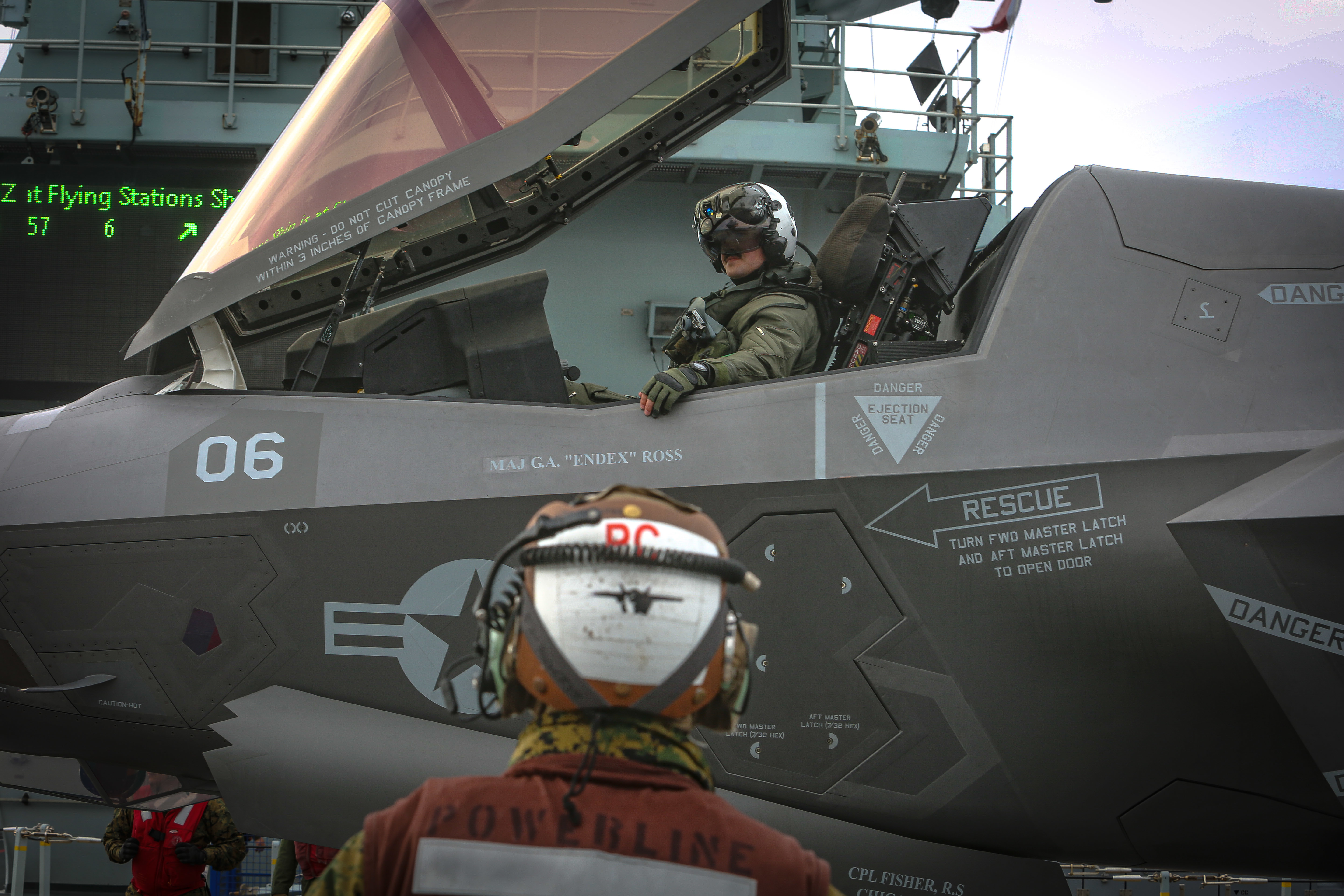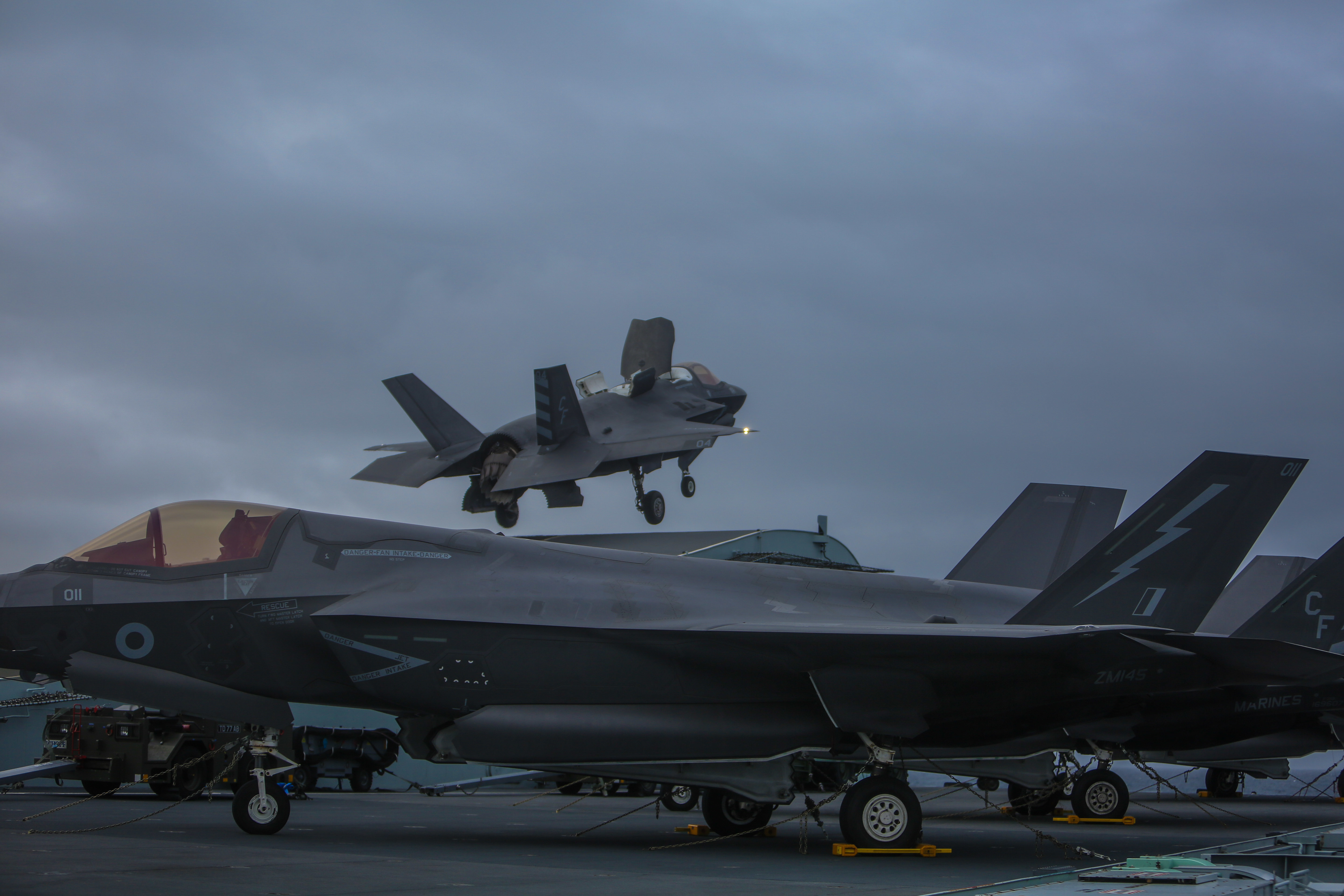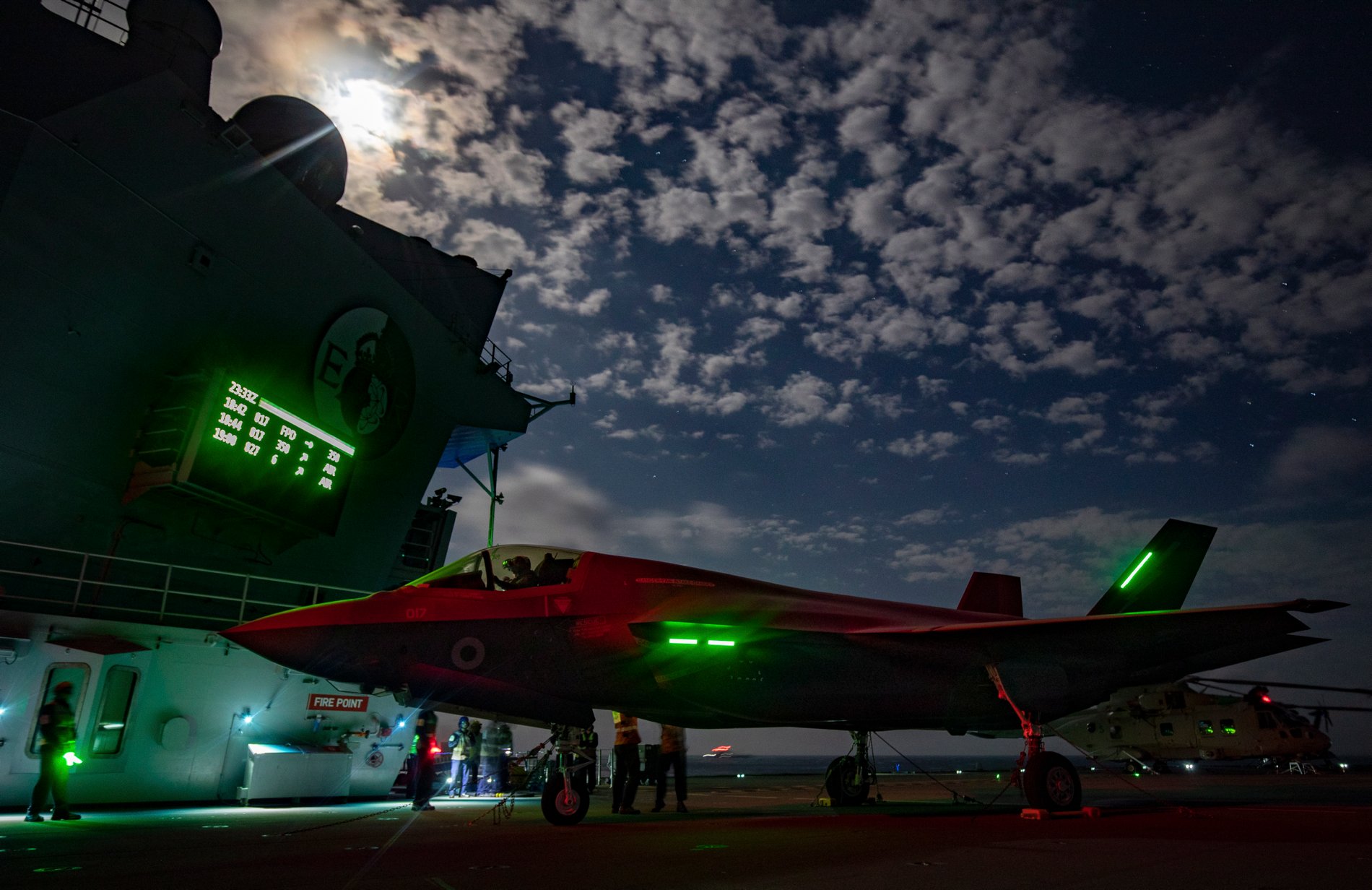
This week a squadron of Marine F-35B Lightning II Joint Strike Fighters wrapped up nearly two months of training aboard the U.K. Royal Navy HMS Queen Elizabeth (R08), paving the way for U.S. and U.K. fighters to operate interchangeably when the British aircraft carrier leaves on its first deployment.
The “Wake Island Avengers” of Marine Fighter Attack Squadron (VMFA) 211 and the Royal Air Force’s 617 Squadron “The Dambusters” used the recent drills to demonstrate the countries can seamlessly fight and maintain the F-35Bs from the carrier.
During a recent interview with USNI News, VMFA-211 commanding officer Lt. Col. Joseph Freshour detailed how the squadrons flew combinations of aircraft, shared parts and performed integrated maintenance throughout the last few weeks.
“The jointness of the F-35 program really came to light, and the interoperability between our two units, our tactics, the digital side of how we integrate with them tactically, everything else – how we maintain the aircraft – all really went off without a real hitch, to the point that we even were able to share parts when necessary,” Freshour said. “We flew mixed elements. So in our divisions at times we had a mix of U.K. and U.S. aircraft. We had U.K. pilots leading some of our U.S. wingman and vice versa.”
For the last several weeks, the U.S. and U.K squadrons have been conducting flight operations off Queen Elizabeth during drills that allowed the two nations to test both the interoperability and the interchangeability they are striving for between navies.
“On day one, we arrived and between the two squadrons put 14 aircraft and subsequently 15 aircraft when the last jet arrived from the U.K., which is nothing like they’d ever been able to practice,” Freshour said. “So I think that’s where the biggest learning and growing took place, was pushing the flight deck and getting the flight deck prepared for what the deployment will look like in that size and scope of aircraft.”
With a total of 15 aircraft – 10 F-35Bs from VMFA-211 and five from RAF 617 – the squadrons used the recent Crimson Warrior and Group Exercise both to practice flight operations and maintenance procedures.
For example, if the U.S. squadron needed a part for its aircraft, it could temporarily use a part from the U.K. and then switch out the part for a U.S. one later on.
“What was really neat is the digital side of it. So when you switch a part from their side to our side in [Autonomic Logistics Information System], that actually was quite seamless and went really well,” Freshour said. “Because that could be a big hindrance to the execution of that – that install of that part. So that was actually a really nice point to learn, is that we were capable of doing that and it went as planned.”

The Marine F-35Bs first got underway aboard Queen Elizabeth in late September. While VMFA-211 left for its first combat deployment in 2018 with the 13th Marine Expeditionary Unit, the training this fall aboard Queen Elizabeth marks the first time F-35Bs have been deployed on a ship from a partner country, according to a Marine Corps news release.
Maj. Christopher Brandt, the VMFA-211 executive officer who was on the 13th MEU deployment, told USNI News that the recent exercises helped American Marines train in weather they’re not accustomed to.
“I think operating in the weather that the U.K. has is a lot different for – our pilots are used to operating around Yuma, which is sunny, you know, 360 days out of the year,” Brandt said. “So I think just that flight experience – along with the experience of the deck crew, like [Freshour] was talking about on the actual ship, as well as the personnel in the tower running the tower operations – I think is a huge thing to build on for when the actual deployment comes around in the spring.”
Unlike American aircraft carriers, Queen Elizabeth is equipped with a ramp from which the F-35Bs can take off. Brandt and Freshour said that while the ramp necessitates slight adjustments, taking off from the British carrier was not all that different from how the Marines operate off of American amphibious ships without the ramp.
“I think it was much simpler to take off from the ramp – a little less procedures for the actual pilot in the cockpit to do,” Brandt said.
“You can take off from a shorter distance just due to the aerodynamics that the ramp is providing. There’s a little bit of a wind difference that – it has some different wind effects, just the way the wind blows around that ramp. But other than that, I don’t think there’s a whole lot of significant difference. So I think it was pretty easy to go from the LHD to the Queen Elizabeth for most of our pilots.”
Freshour, who had participated in pre-qualifications aboard the USS Essex (LHD-2) before the operations on Queen Elizabeth but was not deployed with the 13th MEU, said the aircraft has an automatic takeoff ability that can operate from the ramp on the British carrier or the flat deck of the American amphibious assault ships.
“You would start from that point on the ship lined up with the ramp and literally just take off and let the jet fly itself away,” Freshour said. “It recognizes the type of takeoff programs and the appropriate control laws and then does everything else for you.”
With a much larger deck on Queen Elizabeth compared to the Wasp-class amphibious assault ships, the Marines could fit more F-35s aboard to conduct flight operations.
Before the recent carrier operations, the Marines trained on simulators both in Yuma, Ariz., and Royal Air Force Marham. Brandt said VMFA-211 began training in the simulators at Yuma over the summer ahead of the travel to the U.K.
“Essentially for someone who’s never done it before, you’ll go through at least two normal day [carrier-landing] sims, which are an hour and a half to two hours long, two of the night sims, and then essentially EP simmer – emergency procedures simulator where we just throw jet malfunctions or aircraft malfunctions while operating at the ship,” Brandt said. “So the simulator does a really nice job of simulating the actual ship environment and then the actual feel of the aircraft. So I think every pilot would attest that they felt pretty prepared for the first time they actually flew the aircraft on.”

Brandt, who led the training as the head landing signal office, said getting the systems for F-35 maintenance running with the right connectivity was an “uphill battle at first,” but the drills helped the crew practice ahead of the spring deployment.
“We flew in mixed divisions and sections the whole time we’ve been here. And there’s really no difficulty at all. We all speak the same language in the cockpit, tactically. So that part is easy,” Brandt said. “I think it’s just the small things – getting connectivity working, just physically working in different spaces in the U.K. and then on the ship – that I think we have learned a tremendous amount of lessons for next spring.”
The recent success in preparing for the deployment with the U.K. demonstrates that the U.S. could apply such a model to other partner nations, Freshour said.
While the Royal Navy has not operated aircraft carriers for several decades, Freshour said U.K. officials have participated in exchanges with the U.S. in recent years.
“For example, the commander of the 617 was at VX-9 out in China Lake with Maj. Brandt, you know, a couple years ago. So the [air group commander] himself flew off of carriers on a U.S. Navy exchange, flying Super Hornets,” he said. “The air boss – known as Wings in the U.K. – was the same thing. So a large number of the people involved in the decision-making and the execution on the U.K. side had done U.S. Navy exchanges, which also played a huge part in kind of filling that gap.”
Exchanges extended to American chefs who were aboard Queen Elizabeth for the exercises this fall. The crew ate plenty of fish, according to Brandt.
“The chow was phenomenal,” he said.





